Strategic Leadership and HRM Practices of an Organization Report
VerifiedAdded on 2020/07/22
|9
|2848
|40
Report
AI Summary
This report provides an in-depth analysis of strategic leadership and human resource management (HRM) practices within organizations, using 3M and IHG as case studies. The report begins by defining strategic leadership and its importance, followed by an examination of various HRM functions, including recruitment, selection, and employee engagement at 3M. It explores different recruitment approaches, such as systematic, personalized, and competitive approaches, highlighting their strengths and weaknesses. The importance of employee relations and relevant employment legislation are also discussed. Furthermore, the report delves into change management models, specifically focusing on situational leadership and the ADKAR and Lewin's change management models, and their relevance to IHG. The analysis covers the roles of leaders in driving change, the impact of these models on business operations, and provides practical examples of HRM practices. The report concludes with a summary of key findings and insights into the effective implementation of strategic leadership and HRM strategies.
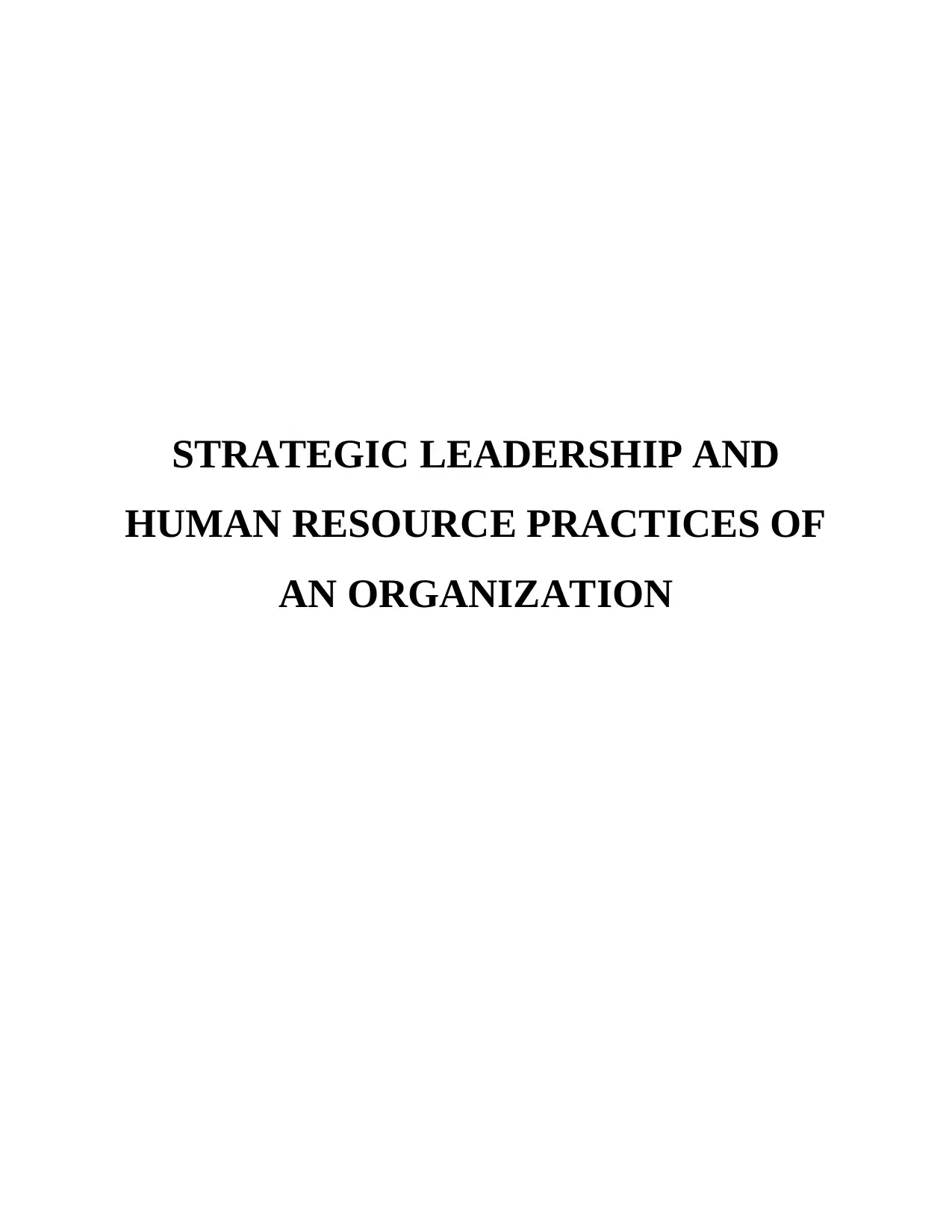
STRATEGIC LEADERSHIP AND
HUMAN RESOURCE PRACTICES OF
AN ORGANIZATION
HUMAN RESOURCE PRACTICES OF
AN ORGANIZATION
Paraphrase This Document
Need a fresh take? Get an instant paraphrase of this document with our AI Paraphraser
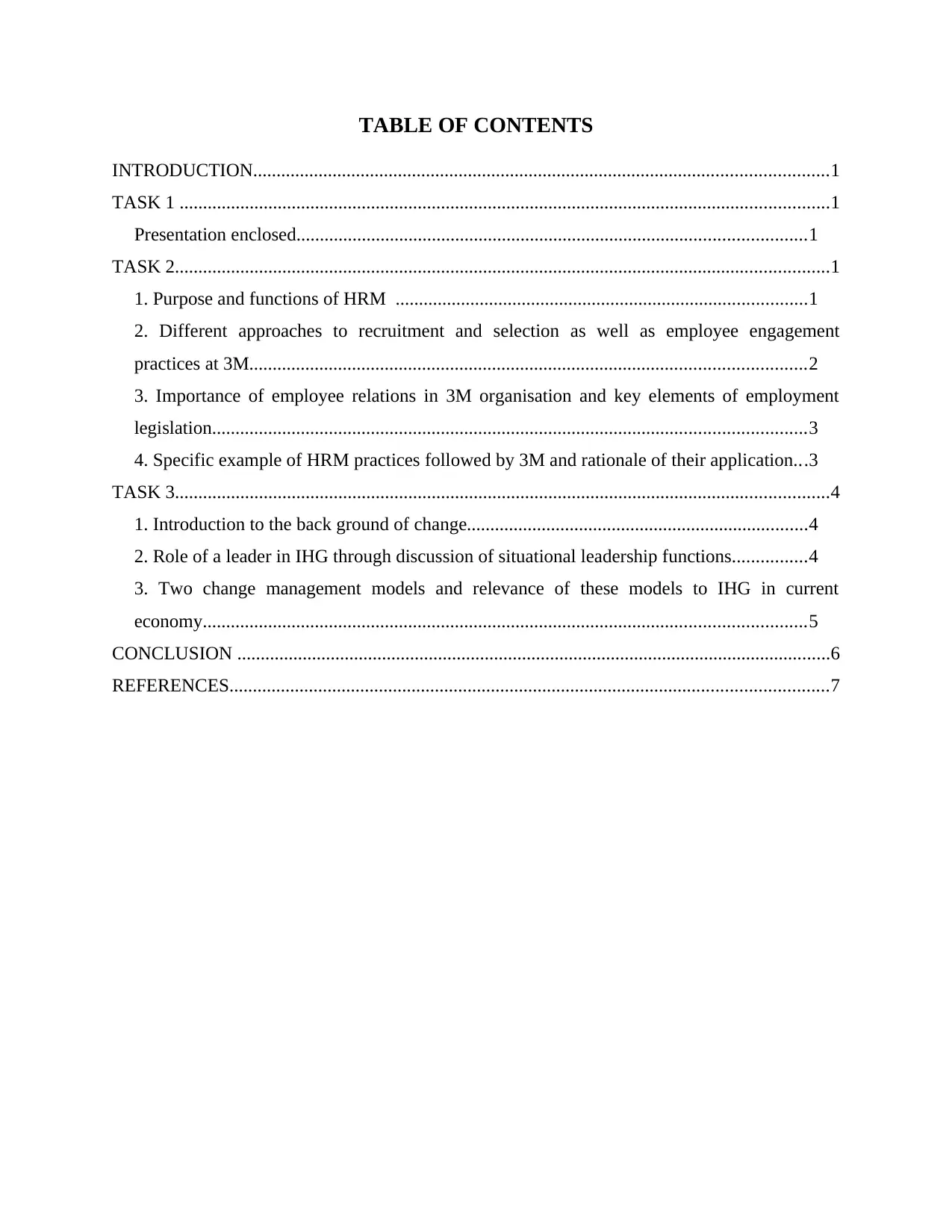
TABLE OF CONTENTS
INTRODUCTION...........................................................................................................................1
TASK 1 ...........................................................................................................................................1
Presentation enclosed.............................................................................................................1
TASK 2............................................................................................................................................1
1. Purpose and functions of HRM ........................................................................................1
2. Different approaches to recruitment and selection as well as employee engagement
practices at 3M.......................................................................................................................2
3. Importance of employee relations in 3M organisation and key elements of employment
legislation...............................................................................................................................3
4. Specific example of HRM practices followed by 3M and rationale of their application...3
TASK 3............................................................................................................................................4
1. Introduction to the back ground of change.........................................................................4
2. Role of a leader in IHG through discussion of situational leadership functions................4
3. Two change management models and relevance of these models to IHG in current
economy.................................................................................................................................5
CONCLUSION ...............................................................................................................................6
REFERENCES................................................................................................................................7
INTRODUCTION...........................................................................................................................1
TASK 1 ...........................................................................................................................................1
Presentation enclosed.............................................................................................................1
TASK 2............................................................................................................................................1
1. Purpose and functions of HRM ........................................................................................1
2. Different approaches to recruitment and selection as well as employee engagement
practices at 3M.......................................................................................................................2
3. Importance of employee relations in 3M organisation and key elements of employment
legislation...............................................................................................................................3
4. Specific example of HRM practices followed by 3M and rationale of their application...3
TASK 3............................................................................................................................................4
1. Introduction to the back ground of change.........................................................................4
2. Role of a leader in IHG through discussion of situational leadership functions................4
3. Two change management models and relevance of these models to IHG in current
economy.................................................................................................................................5
CONCLUSION ...............................................................................................................................6
REFERENCES................................................................................................................................7
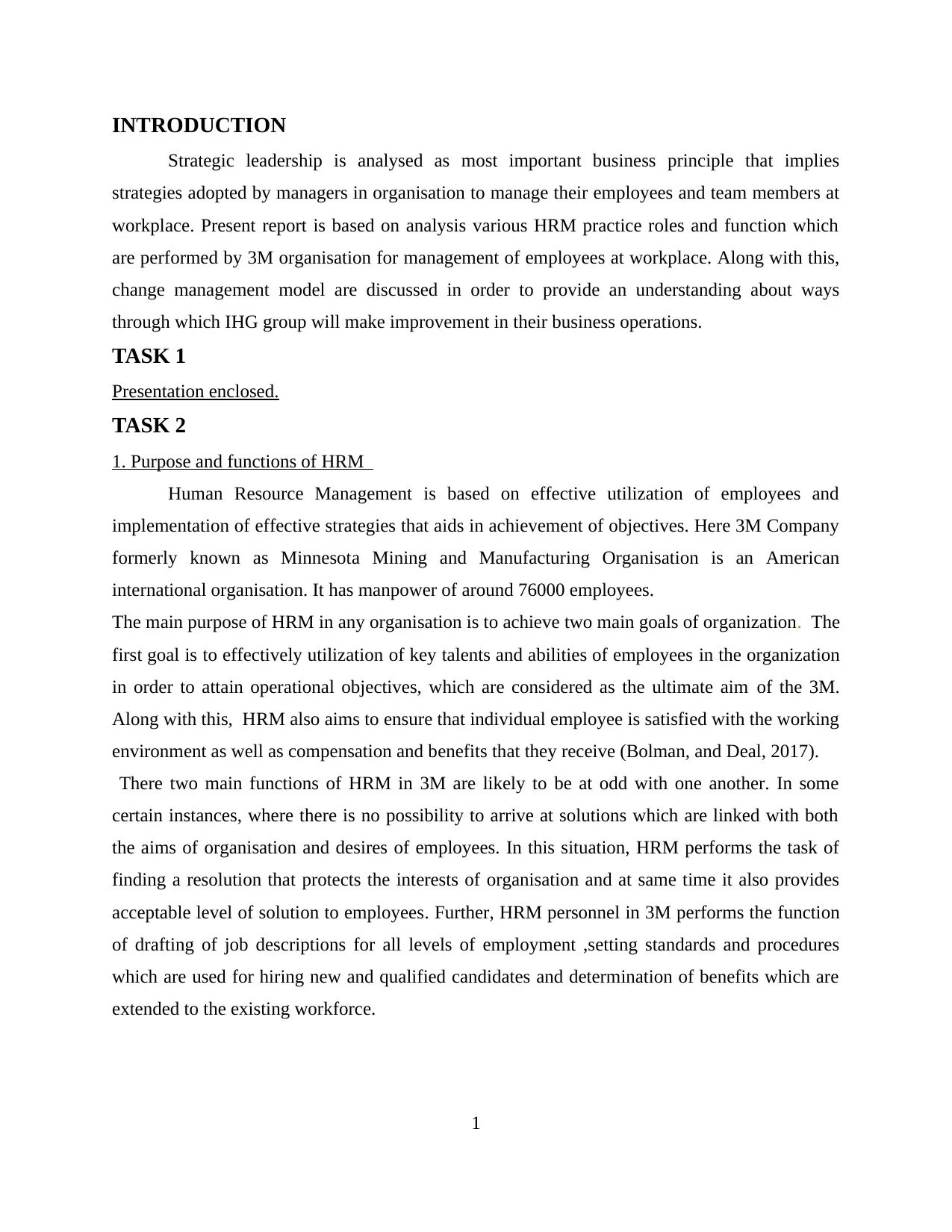
INTRODUCTION
Strategic leadership is analysed as most important business principle that implies
strategies adopted by managers in organisation to manage their employees and team members at
workplace. Present report is based on analysis various HRM practice roles and function which
are performed by 3M organisation for management of employees at workplace. Along with this,
change management model are discussed in order to provide an understanding about ways
through which IHG group will make improvement in their business operations.
TASK 1
Presentation enclosed.
TASK 2
1. Purpose and functions of HRM
Human Resource Management is based on effective utilization of employees and
implementation of effective strategies that aids in achievement of objectives. Here 3M Company
formerly known as Minnesota Mining and Manufacturing Organisation is an American
international organisation. It has manpower of around 76000 employees.
The main purpose of HRM in any organisation is to achieve two main goals of organization. The
first goal is to effectively utilization of key talents and abilities of employees in the organization
in order to attain operational objectives, which are considered as the ultimate aim of the 3M.
Along with this, HRM also aims to ensure that individual employee is satisfied with the working
environment as well as compensation and benefits that they receive (Bolman, and Deal, 2017).
There two main functions of HRM in 3M are likely to be at odd with one another. In some
certain instances, where there is no possibility to arrive at solutions which are linked with both
the aims of organisation and desires of employees. In this situation, HRM performs the task of
finding a resolution that protects the interests of organisation and at same time it also provides
acceptable level of solution to employees. Further, HRM personnel in 3M performs the function
of drafting of job descriptions for all levels of employment ,setting standards and procedures
which are used for hiring new and qualified candidates and determination of benefits which are
extended to the existing workforce.
1
Strategic leadership is analysed as most important business principle that implies
strategies adopted by managers in organisation to manage their employees and team members at
workplace. Present report is based on analysis various HRM practice roles and function which
are performed by 3M organisation for management of employees at workplace. Along with this,
change management model are discussed in order to provide an understanding about ways
through which IHG group will make improvement in their business operations.
TASK 1
Presentation enclosed.
TASK 2
1. Purpose and functions of HRM
Human Resource Management is based on effective utilization of employees and
implementation of effective strategies that aids in achievement of objectives. Here 3M Company
formerly known as Minnesota Mining and Manufacturing Organisation is an American
international organisation. It has manpower of around 76000 employees.
The main purpose of HRM in any organisation is to achieve two main goals of organization. The
first goal is to effectively utilization of key talents and abilities of employees in the organization
in order to attain operational objectives, which are considered as the ultimate aim of the 3M.
Along with this, HRM also aims to ensure that individual employee is satisfied with the working
environment as well as compensation and benefits that they receive (Bolman, and Deal, 2017).
There two main functions of HRM in 3M are likely to be at odd with one another. In some
certain instances, where there is no possibility to arrive at solutions which are linked with both
the aims of organisation and desires of employees. In this situation, HRM performs the task of
finding a resolution that protects the interests of organisation and at same time it also provides
acceptable level of solution to employees. Further, HRM personnel in 3M performs the function
of drafting of job descriptions for all levels of employment ,setting standards and procedures
which are used for hiring new and qualified candidates and determination of benefits which are
extended to the existing workforce.
1
⊘ This is a preview!⊘
Do you want full access?
Subscribe today to unlock all pages.

Trusted by 1+ million students worldwide
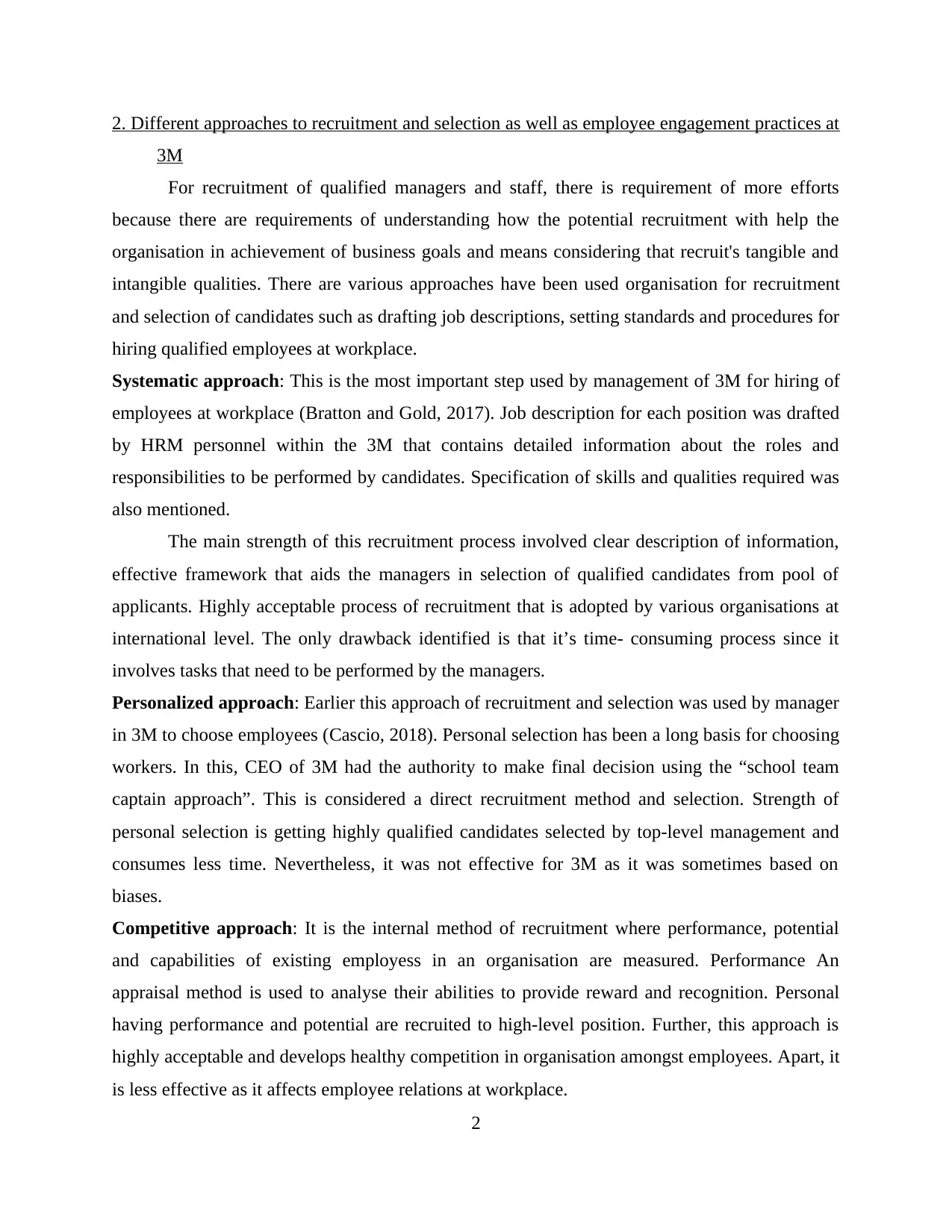
2. Different approaches to recruitment and selection as well as employee engagement practices at
3M
For recruitment of qualified managers and staff, there is requirement of more efforts
because there are requirements of understanding how the potential recruitment with help the
organisation in achievement of business goals and means considering that recruit's tangible and
intangible qualities. There are various approaches have been used organisation for recruitment
and selection of candidates such as drafting job descriptions, setting standards and procedures for
hiring qualified employees at workplace.
Systematic approach: This is the most important step used by management of 3M for hiring of
employees at workplace (Bratton and Gold, 2017). Job description for each position was drafted
by HRM personnel within the 3M that contains detailed information about the roles and
responsibilities to be performed by candidates. Specification of skills and qualities required was
also mentioned.
The main strength of this recruitment process involved clear description of information,
effective framework that aids the managers in selection of qualified candidates from pool of
applicants. Highly acceptable process of recruitment that is adopted by various organisations at
international level. The only drawback identified is that it’s time- consuming process since it
involves tasks that need to be performed by the managers.
Personalized approach: Earlier this approach of recruitment and selection was used by manager
in 3M to choose employees (Cascio, 2018). Personal selection has been a long basis for choosing
workers. In this, CEO of 3M had the authority to make final decision using the “school team
captain approach”. This is considered a direct recruitment method and selection. Strength of
personal selection is getting highly qualified candidates selected by top-level management and
consumes less time. Nevertheless, it was not effective for 3M as it was sometimes based on
biases.
Competitive approach: It is the internal method of recruitment where performance, potential
and capabilities of existing employess in an organisation are measured. Performance An
appraisal method is used to analyse their abilities to provide reward and recognition. Personal
having performance and potential are recruited to high-level position. Further, this approach is
highly acceptable and develops healthy competition in organisation amongst employees. Apart, it
is less effective as it affects employee relations at workplace.
2
3M
For recruitment of qualified managers and staff, there is requirement of more efforts
because there are requirements of understanding how the potential recruitment with help the
organisation in achievement of business goals and means considering that recruit's tangible and
intangible qualities. There are various approaches have been used organisation for recruitment
and selection of candidates such as drafting job descriptions, setting standards and procedures for
hiring qualified employees at workplace.
Systematic approach: This is the most important step used by management of 3M for hiring of
employees at workplace (Bratton and Gold, 2017). Job description for each position was drafted
by HRM personnel within the 3M that contains detailed information about the roles and
responsibilities to be performed by candidates. Specification of skills and qualities required was
also mentioned.
The main strength of this recruitment process involved clear description of information,
effective framework that aids the managers in selection of qualified candidates from pool of
applicants. Highly acceptable process of recruitment that is adopted by various organisations at
international level. The only drawback identified is that it’s time- consuming process since it
involves tasks that need to be performed by the managers.
Personalized approach: Earlier this approach of recruitment and selection was used by manager
in 3M to choose employees (Cascio, 2018). Personal selection has been a long basis for choosing
workers. In this, CEO of 3M had the authority to make final decision using the “school team
captain approach”. This is considered a direct recruitment method and selection. Strength of
personal selection is getting highly qualified candidates selected by top-level management and
consumes less time. Nevertheless, it was not effective for 3M as it was sometimes based on
biases.
Competitive approach: It is the internal method of recruitment where performance, potential
and capabilities of existing employess in an organisation are measured. Performance An
appraisal method is used to analyse their abilities to provide reward and recognition. Personal
having performance and potential are recruited to high-level position. Further, this approach is
highly acceptable and develops healthy competition in organisation amongst employees. Apart, it
is less effective as it affects employee relations at workplace.
2
Paraphrase This Document
Need a fresh take? Get an instant paraphrase of this document with our AI Paraphraser
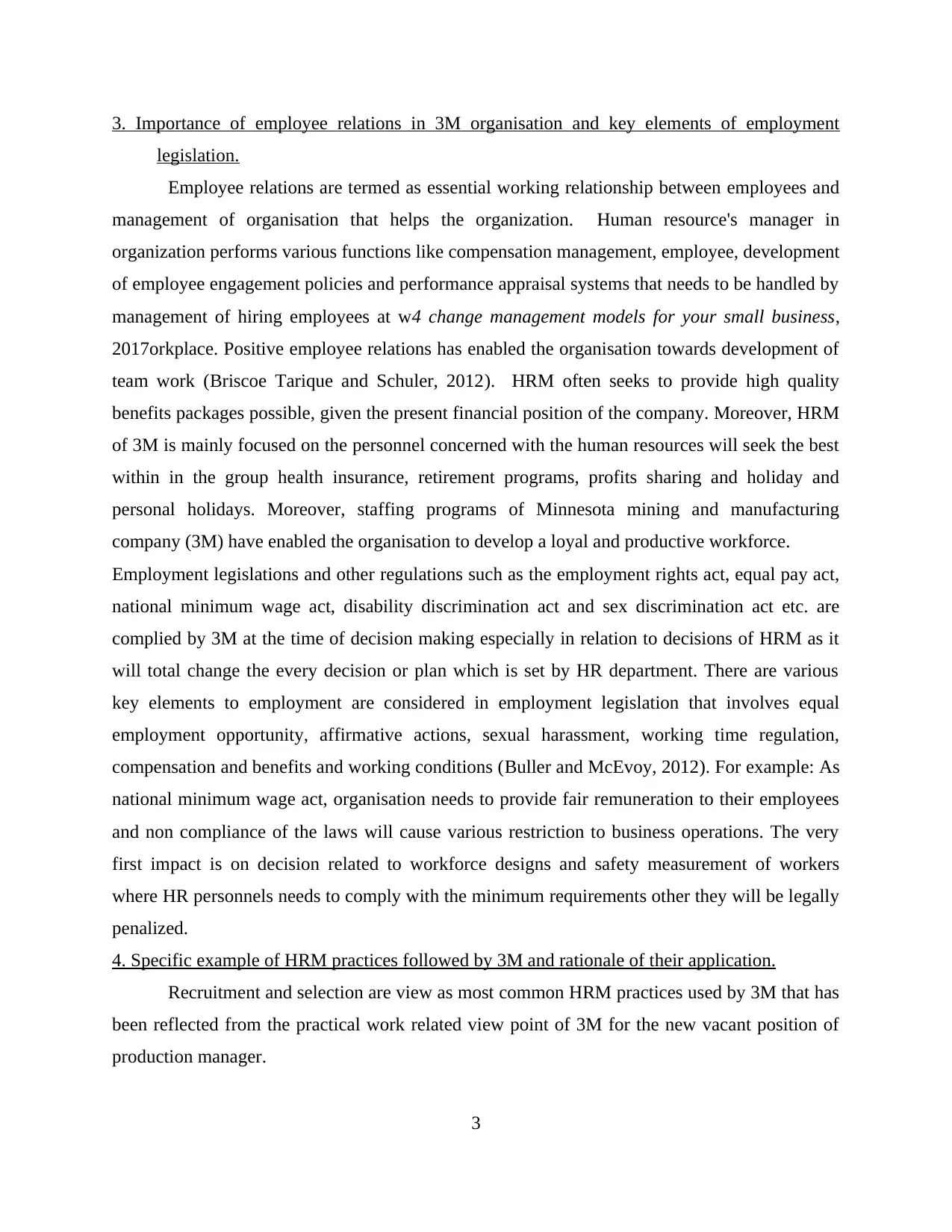
3. Importance of employee relations in 3M organisation and key elements of employment
legislation.
Employee relations are termed as essential working relationship between employees and
management of organisation that helps the organization. Human resource's manager in
organization performs various functions like compensation management, employee, development
of employee engagement policies and performance appraisal systems that needs to be handled by
management of hiring employees at w4 change management models for your small business,
2017orkplace. Positive employee relations has enabled the organisation towards development of
team work (Briscoe Tarique and Schuler, 2012). HRM often seeks to provide high quality
benefits packages possible, given the present financial position of the company. Moreover, HRM
of 3M is mainly focused on the personnel concerned with the human resources will seek the best
within in the group health insurance, retirement programs, profits sharing and holiday and
personal holidays. Moreover, staffing programs of Minnesota mining and manufacturing
company (3M) have enabled the organisation to develop a loyal and productive workforce.
Employment legislations and other regulations such as the employment rights act, equal pay act,
national minimum wage act, disability discrimination act and sex discrimination act etc. are
complied by 3M at the time of decision making especially in relation to decisions of HRM as it
will total change the every decision or plan which is set by HR department. There are various
key elements to employment are considered in employment legislation that involves equal
employment opportunity, affirmative actions, sexual harassment, working time regulation,
compensation and benefits and working conditions (Buller and McEvoy, 2012). For example: As
national minimum wage act, organisation needs to provide fair remuneration to their employees
and non compliance of the laws will cause various restriction to business operations. The very
first impact is on decision related to workforce designs and safety measurement of workers
where HR personnels needs to comply with the minimum requirements other they will be legally
penalized.
4. Specific example of HRM practices followed by 3M and rationale of their application.
Recruitment and selection are view as most common HRM practices used by 3M that has
been reflected from the practical work related view point of 3M for the new vacant position of
production manager.
3
legislation.
Employee relations are termed as essential working relationship between employees and
management of organisation that helps the organization. Human resource's manager in
organization performs various functions like compensation management, employee, development
of employee engagement policies and performance appraisal systems that needs to be handled by
management of hiring employees at w4 change management models for your small business,
2017orkplace. Positive employee relations has enabled the organisation towards development of
team work (Briscoe Tarique and Schuler, 2012). HRM often seeks to provide high quality
benefits packages possible, given the present financial position of the company. Moreover, HRM
of 3M is mainly focused on the personnel concerned with the human resources will seek the best
within in the group health insurance, retirement programs, profits sharing and holiday and
personal holidays. Moreover, staffing programs of Minnesota mining and manufacturing
company (3M) have enabled the organisation to develop a loyal and productive workforce.
Employment legislations and other regulations such as the employment rights act, equal pay act,
national minimum wage act, disability discrimination act and sex discrimination act etc. are
complied by 3M at the time of decision making especially in relation to decisions of HRM as it
will total change the every decision or plan which is set by HR department. There are various
key elements to employment are considered in employment legislation that involves equal
employment opportunity, affirmative actions, sexual harassment, working time regulation,
compensation and benefits and working conditions (Buller and McEvoy, 2012). For example: As
national minimum wage act, organisation needs to provide fair remuneration to their employees
and non compliance of the laws will cause various restriction to business operations. The very
first impact is on decision related to workforce designs and safety measurement of workers
where HR personnels needs to comply with the minimum requirements other they will be legally
penalized.
4. Specific example of HRM practices followed by 3M and rationale of their application.
Recruitment and selection are view as most common HRM practices used by 3M that has
been reflected from the practical work related view point of 3M for the new vacant position of
production manager.
3
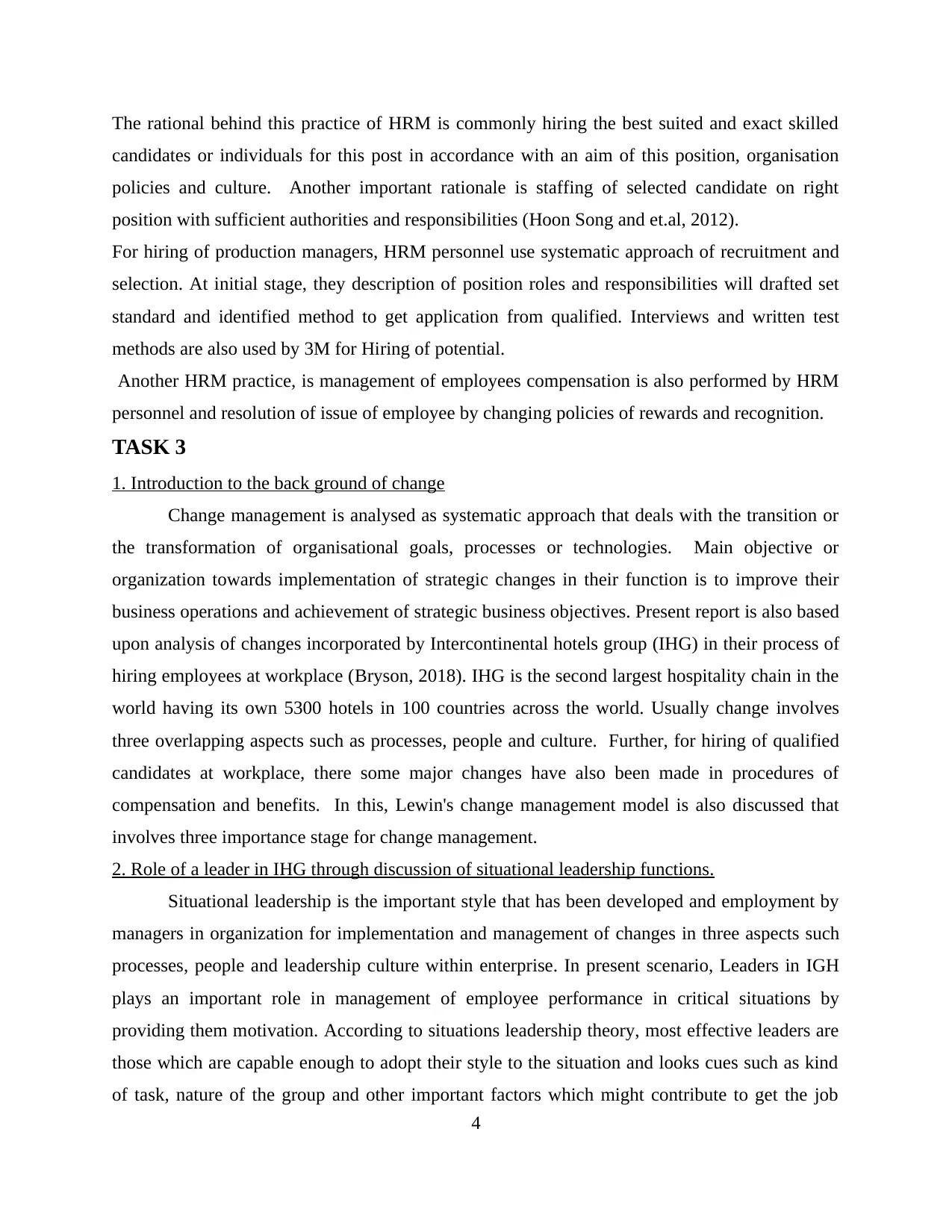
The rational behind this practice of HRM is commonly hiring the best suited and exact skilled
candidates or individuals for this post in accordance with an aim of this position, organisation
policies and culture. Another important rationale is staffing of selected candidate on right
position with sufficient authorities and responsibilities (Hoon Song and et.al, 2012).
For hiring of production managers, HRM personnel use systematic approach of recruitment and
selection. At initial stage, they description of position roles and responsibilities will drafted set
standard and identified method to get application from qualified. Interviews and written test
methods are also used by 3M for Hiring of potential.
Another HRM practice, is management of employees compensation is also performed by HRM
personnel and resolution of issue of employee by changing policies of rewards and recognition.
TASK 3
1. Introduction to the back ground of change
Change management is analysed as systematic approach that deals with the transition or
the transformation of organisational goals, processes or technologies. Main objective or
organization towards implementation of strategic changes in their function is to improve their
business operations and achievement of strategic business objectives. Present report is also based
upon analysis of changes incorporated by Intercontinental hotels group (IHG) in their process of
hiring employees at workplace (Bryson, 2018). IHG is the second largest hospitality chain in the
world having its own 5300 hotels in 100 countries across the world. Usually change involves
three overlapping aspects such as processes, people and culture. Further, for hiring of qualified
candidates at workplace, there some major changes have also been made in procedures of
compensation and benefits. In this, Lewin's change management model is also discussed that
involves three importance stage for change management.
2. Role of a leader in IHG through discussion of situational leadership functions.
Situational leadership is the important style that has been developed and employment by
managers in organization for implementation and management of changes in three aspects such
processes, people and leadership culture within enterprise. In present scenario, Leaders in IGH
plays an important role in management of employee performance in critical situations by
providing them motivation. According to situations leadership theory, most effective leaders are
those which are capable enough to adopt their style to the situation and looks cues such as kind
of task, nature of the group and other important factors which might contribute to get the job
4
candidates or individuals for this post in accordance with an aim of this position, organisation
policies and culture. Another important rationale is staffing of selected candidate on right
position with sufficient authorities and responsibilities (Hoon Song and et.al, 2012).
For hiring of production managers, HRM personnel use systematic approach of recruitment and
selection. At initial stage, they description of position roles and responsibilities will drafted set
standard and identified method to get application from qualified. Interviews and written test
methods are also used by 3M for Hiring of potential.
Another HRM practice, is management of employees compensation is also performed by HRM
personnel and resolution of issue of employee by changing policies of rewards and recognition.
TASK 3
1. Introduction to the back ground of change
Change management is analysed as systematic approach that deals with the transition or
the transformation of organisational goals, processes or technologies. Main objective or
organization towards implementation of strategic changes in their function is to improve their
business operations and achievement of strategic business objectives. Present report is also based
upon analysis of changes incorporated by Intercontinental hotels group (IHG) in their process of
hiring employees at workplace (Bryson, 2018). IHG is the second largest hospitality chain in the
world having its own 5300 hotels in 100 countries across the world. Usually change involves
three overlapping aspects such as processes, people and culture. Further, for hiring of qualified
candidates at workplace, there some major changes have also been made in procedures of
compensation and benefits. In this, Lewin's change management model is also discussed that
involves three importance stage for change management.
2. Role of a leader in IHG through discussion of situational leadership functions.
Situational leadership is the important style that has been developed and employment by
managers in organization for implementation and management of changes in three aspects such
processes, people and leadership culture within enterprise. In present scenario, Leaders in IGH
plays an important role in management of employee performance in critical situations by
providing them motivation. According to situations leadership theory, most effective leaders are
those which are capable enough to adopt their style to the situation and looks cues such as kind
of task, nature of the group and other important factors which might contribute to get the job
4
⊘ This is a preview!⊘
Do you want full access?
Subscribe today to unlock all pages.

Trusted by 1+ million students worldwide
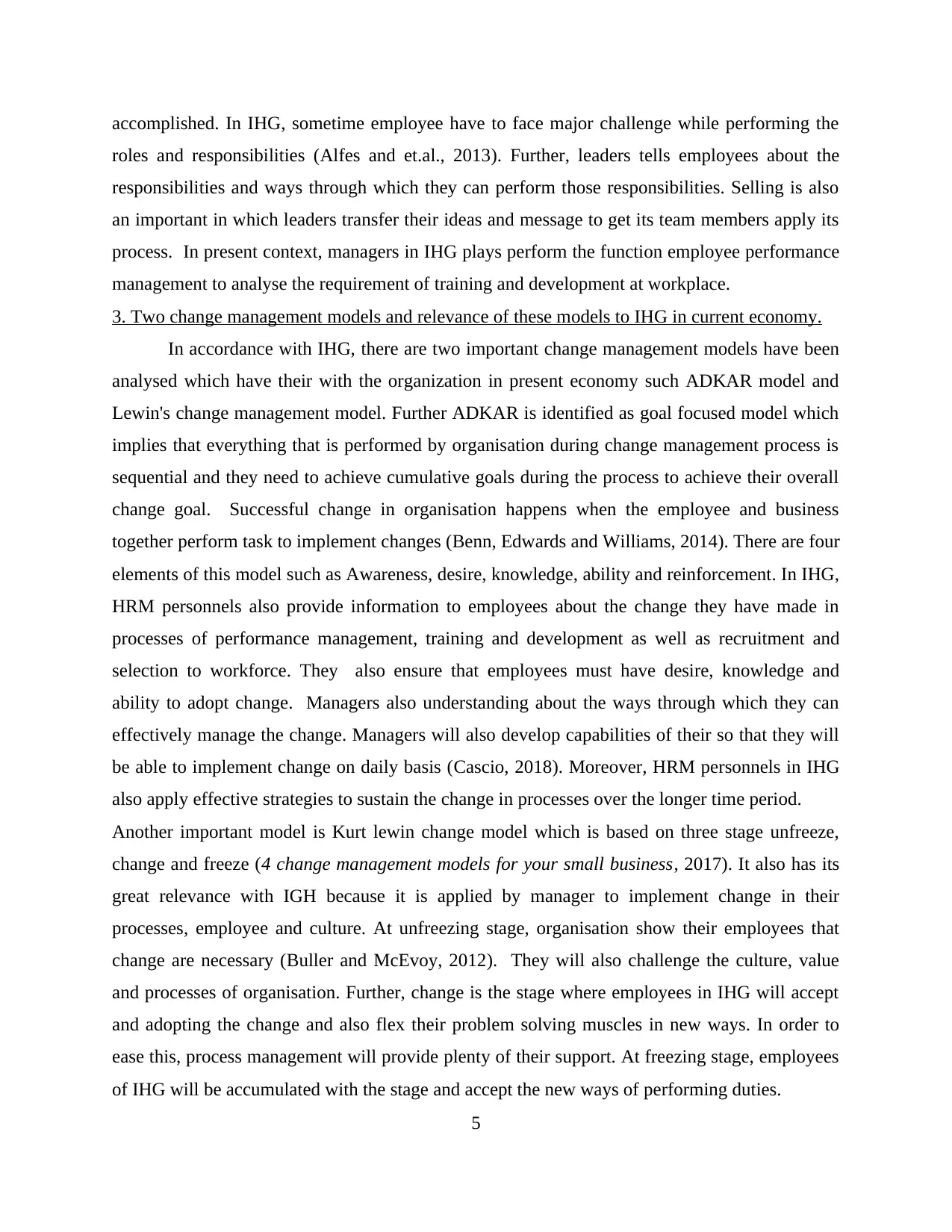
accomplished. In IHG, sometime employee have to face major challenge while performing the
roles and responsibilities (Alfes and et.al., 2013). Further, leaders tells employees about the
responsibilities and ways through which they can perform those responsibilities. Selling is also
an important in which leaders transfer their ideas and message to get its team members apply its
process. In present context, managers in IHG plays perform the function employee performance
management to analyse the requirement of training and development at workplace.
3. Two change management models and relevance of these models to IHG in current economy.
In accordance with IHG, there are two important change management models have been
analysed which have their with the organization in present economy such ADKAR model and
Lewin's change management model. Further ADKAR is identified as goal focused model which
implies that everything that is performed by organisation during change management process is
sequential and they need to achieve cumulative goals during the process to achieve their overall
change goal. Successful change in organisation happens when the employee and business
together perform task to implement changes (Benn, Edwards and Williams, 2014). There are four
elements of this model such as Awareness, desire, knowledge, ability and reinforcement. In IHG,
HRM personnels also provide information to employees about the change they have made in
processes of performance management, training and development as well as recruitment and
selection to workforce. They also ensure that employees must have desire, knowledge and
ability to adopt change. Managers also understanding about the ways through which they can
effectively manage the change. Managers will also develop capabilities of their so that they will
be able to implement change on daily basis (Cascio, 2018). Moreover, HRM personnels in IHG
also apply effective strategies to sustain the change in processes over the longer time period.
Another important model is Kurt lewin change model which is based on three stage unfreeze,
change and freeze (4 change management models for your small business, 2017). It also has its
great relevance with IGH because it is applied by manager to implement change in their
processes, employee and culture. At unfreezing stage, organisation show their employees that
change are necessary (Buller and McEvoy, 2012). They will also challenge the culture, value
and processes of organisation. Further, change is the stage where employees in IHG will accept
and adopting the change and also flex their problem solving muscles in new ways. In order to
ease this, process management will provide plenty of their support. At freezing stage, employees
of IHG will be accumulated with the stage and accept the new ways of performing duties.
5
roles and responsibilities (Alfes and et.al., 2013). Further, leaders tells employees about the
responsibilities and ways through which they can perform those responsibilities. Selling is also
an important in which leaders transfer their ideas and message to get its team members apply its
process. In present context, managers in IHG plays perform the function employee performance
management to analyse the requirement of training and development at workplace.
3. Two change management models and relevance of these models to IHG in current economy.
In accordance with IHG, there are two important change management models have been
analysed which have their with the organization in present economy such ADKAR model and
Lewin's change management model. Further ADKAR is identified as goal focused model which
implies that everything that is performed by organisation during change management process is
sequential and they need to achieve cumulative goals during the process to achieve their overall
change goal. Successful change in organisation happens when the employee and business
together perform task to implement changes (Benn, Edwards and Williams, 2014). There are four
elements of this model such as Awareness, desire, knowledge, ability and reinforcement. In IHG,
HRM personnels also provide information to employees about the change they have made in
processes of performance management, training and development as well as recruitment and
selection to workforce. They also ensure that employees must have desire, knowledge and
ability to adopt change. Managers also understanding about the ways through which they can
effectively manage the change. Managers will also develop capabilities of their so that they will
be able to implement change on daily basis (Cascio, 2018). Moreover, HRM personnels in IHG
also apply effective strategies to sustain the change in processes over the longer time period.
Another important model is Kurt lewin change model which is based on three stage unfreeze,
change and freeze (4 change management models for your small business, 2017). It also has its
great relevance with IGH because it is applied by manager to implement change in their
processes, employee and culture. At unfreezing stage, organisation show their employees that
change are necessary (Buller and McEvoy, 2012). They will also challenge the culture, value
and processes of organisation. Further, change is the stage where employees in IHG will accept
and adopting the change and also flex their problem solving muscles in new ways. In order to
ease this, process management will provide plenty of their support. At freezing stage, employees
of IHG will be accumulated with the stage and accept the new ways of performing duties.
5
Paraphrase This Document
Need a fresh take? Get an instant paraphrase of this document with our AI Paraphraser
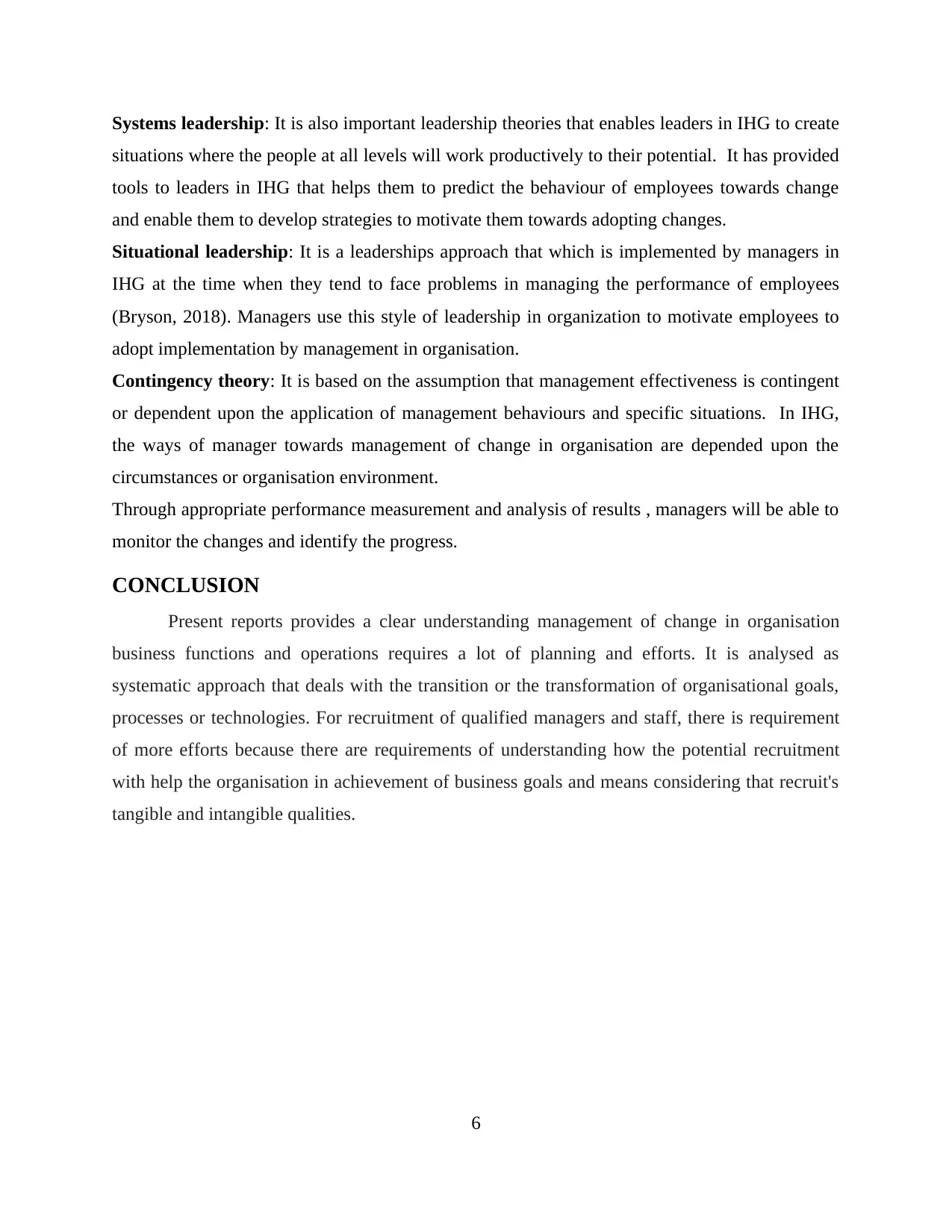
Systems leadership: It is also important leadership theories that enables leaders in IHG to create
situations where the people at all levels will work productively to their potential. It has provided
tools to leaders in IHG that helps them to predict the behaviour of employees towards change
and enable them to develop strategies to motivate them towards adopting changes.
Situational leadership: It is a leaderships approach that which is implemented by managers in
IHG at the time when they tend to face problems in managing the performance of employees
(Bryson, 2018). Managers use this style of leadership in organization to motivate employees to
adopt implementation by management in organisation.
Contingency theory: It is based on the assumption that management effectiveness is contingent
or dependent upon the application of management behaviours and specific situations. In IHG,
the ways of manager towards management of change in organisation are depended upon the
circumstances or organisation environment.
Through appropriate performance measurement and analysis of results , managers will be able to
monitor the changes and identify the progress.
CONCLUSION
Present reports provides a clear understanding management of change in organisation
business functions and operations requires a lot of planning and efforts. It is analysed as
systematic approach that deals with the transition or the transformation of organisational goals,
processes or technologies. For recruitment of qualified managers and staff, there is requirement
of more efforts because there are requirements of understanding how the potential recruitment
with help the organisation in achievement of business goals and means considering that recruit's
tangible and intangible qualities.
6
situations where the people at all levels will work productively to their potential. It has provided
tools to leaders in IHG that helps them to predict the behaviour of employees towards change
and enable them to develop strategies to motivate them towards adopting changes.
Situational leadership: It is a leaderships approach that which is implemented by managers in
IHG at the time when they tend to face problems in managing the performance of employees
(Bryson, 2018). Managers use this style of leadership in organization to motivate employees to
adopt implementation by management in organisation.
Contingency theory: It is based on the assumption that management effectiveness is contingent
or dependent upon the application of management behaviours and specific situations. In IHG,
the ways of manager towards management of change in organisation are depended upon the
circumstances or organisation environment.
Through appropriate performance measurement and analysis of results , managers will be able to
monitor the changes and identify the progress.
CONCLUSION
Present reports provides a clear understanding management of change in organisation
business functions and operations requires a lot of planning and efforts. It is analysed as
systematic approach that deals with the transition or the transformation of organisational goals,
processes or technologies. For recruitment of qualified managers and staff, there is requirement
of more efforts because there are requirements of understanding how the potential recruitment
with help the organisation in achievement of business goals and means considering that recruit's
tangible and intangible qualities.
6
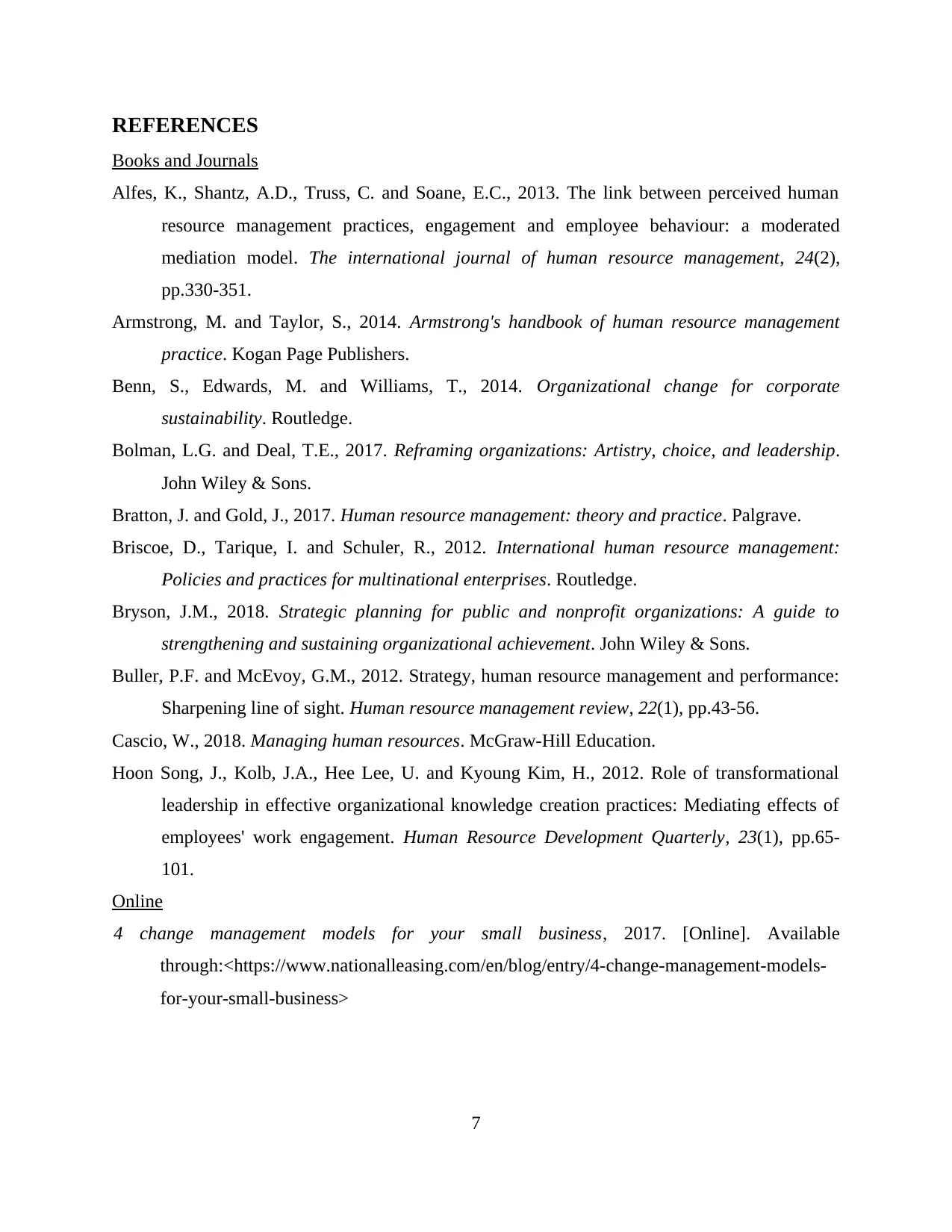
REFERENCES
Books and Journals
Alfes, K., Shantz, A.D., Truss, C. and Soane, E.C., 2013. The link between perceived human
resource management practices, engagement and employee behaviour: a moderated
mediation model. The international journal of human resource management, 24(2),
pp.330-351.
Armstrong, M. and Taylor, S., 2014. Armstrong's handbook of human resource management
practice. Kogan Page Publishers.
Benn, S., Edwards, M. and Williams, T., 2014. Organizational change for corporate
sustainability. Routledge.
Bolman, L.G. and Deal, T.E., 2017. Reframing organizations: Artistry, choice, and leadership.
John Wiley & Sons.
Bratton, J. and Gold, J., 2017. Human resource management: theory and practice. Palgrave.
Briscoe, D., Tarique, I. and Schuler, R., 2012. International human resource management:
Policies and practices for multinational enterprises. Routledge.
Bryson, J.M., 2018. Strategic planning for public and nonprofit organizations: A guide to
strengthening and sustaining organizational achievement. John Wiley & Sons.
Buller, P.F. and McEvoy, G.M., 2012. Strategy, human resource management and performance:
Sharpening line of sight. Human resource management review, 22(1), pp.43-56.
Cascio, W., 2018. Managing human resources. McGraw-Hill Education.
Hoon Song, J., Kolb, J.A., Hee Lee, U. and Kyoung Kim, H., 2012. Role of transformational
leadership in effective organizational knowledge creation practices: Mediating effects of
employees' work engagement. Human Resource Development Quarterly, 23(1), pp.65-
101.
Online
4 change management models for your small business, 2017. [Online]. Available
through:<https://www.nationalleasing.com/en/blog/entry/4-change-management-models-
for-your-small-business>
7
Books and Journals
Alfes, K., Shantz, A.D., Truss, C. and Soane, E.C., 2013. The link between perceived human
resource management practices, engagement and employee behaviour: a moderated
mediation model. The international journal of human resource management, 24(2),
pp.330-351.
Armstrong, M. and Taylor, S., 2014. Armstrong's handbook of human resource management
practice. Kogan Page Publishers.
Benn, S., Edwards, M. and Williams, T., 2014. Organizational change for corporate
sustainability. Routledge.
Bolman, L.G. and Deal, T.E., 2017. Reframing organizations: Artistry, choice, and leadership.
John Wiley & Sons.
Bratton, J. and Gold, J., 2017. Human resource management: theory and practice. Palgrave.
Briscoe, D., Tarique, I. and Schuler, R., 2012. International human resource management:
Policies and practices for multinational enterprises. Routledge.
Bryson, J.M., 2018. Strategic planning for public and nonprofit organizations: A guide to
strengthening and sustaining organizational achievement. John Wiley & Sons.
Buller, P.F. and McEvoy, G.M., 2012. Strategy, human resource management and performance:
Sharpening line of sight. Human resource management review, 22(1), pp.43-56.
Cascio, W., 2018. Managing human resources. McGraw-Hill Education.
Hoon Song, J., Kolb, J.A., Hee Lee, U. and Kyoung Kim, H., 2012. Role of transformational
leadership in effective organizational knowledge creation practices: Mediating effects of
employees' work engagement. Human Resource Development Quarterly, 23(1), pp.65-
101.
Online
4 change management models for your small business, 2017. [Online]. Available
through:<https://www.nationalleasing.com/en/blog/entry/4-change-management-models-
for-your-small-business>
7
⊘ This is a preview!⊘
Do you want full access?
Subscribe today to unlock all pages.

Trusted by 1+ million students worldwide
1 out of 9
Related Documents
Your All-in-One AI-Powered Toolkit for Academic Success.
+13062052269
info@desklib.com
Available 24*7 on WhatsApp / Email
![[object Object]](/_next/static/media/star-bottom.7253800d.svg)
Unlock your academic potential
Copyright © 2020–2025 A2Z Services. All Rights Reserved. Developed and managed by ZUCOL.



